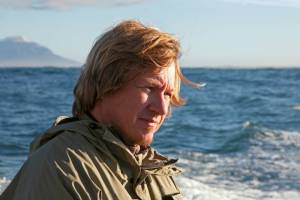AT: How much waiting around did you do in order to capture these sharks?
JK: Sometimes you can go two weeks and not see a single shark. That’s exactly what happened to us. We were sitting in our hotel rooms everyday, nervously watching the clock and hoping that something will change. Sharks are really unpredictable. They come and go and no one really knows why. We spent two weeks with our crew and cameras waiting, and hoping the sharks would return. You just have to be ready when they do come back. Ironically, on the very last day of filming we had some of the best shark breaches we were able to capture.
(More on TIME: Why We Swim With Sharks)
When you are filming, you’ll often have to wait for hours at a time, but with the camera on your shoulder in focus, rolling and ready to go. Once the breach has happened, it’s very difficult to predict. Obviously, it’s very difficult for a seal to predict, so for a human on a boat it’s nearly impossible. You often have to wait a few hours with a heavy camera on your shoulder. And, out of every breach that you see on the program, we probably missed three or four.

Jeff Kurr in False Bay South Africa at the notorious Seal Island. (Photo by: Discovery/SkyReel Aerial)
AT: Tell me a bit about the Seal Eye camera. It’s your own design?
JK: Yes. With help from a noted Hollywood prop maker, Eddie Paul, we sat down and designed this camera. The idea of the Seal Eye is to see what one of these attacks looks like from underwater. That tells us what these sharks are doing while they’re stalking the seals prior to an attack. The Seal Eye was towed behind the boat and we towed a decoy behind that. We were able to monitor the camera and see the sharks down below the decoy. We could actually see them looking up and launching these attacks from under water.
We really got a sense of the acceleration these sharks have. With two or three flicks of the tail, they’re going from a slow cruise to 25 miles an hour or more. That’s enough momentum to get them airborne. In a second’s time, they’re 35-feet deep to the surface. How these seals can escape that? It boggles the mind. Seal Eye also tells us a lot about how efficient these animals are as hunters. Research has shown that great whites are some of the most efficient hunters in nature. They’re more efficient than lions or cheetahs or any other terrestrial animal.
AT: The scene where Chris lures the sharks with his kayak is really intense. I’d be terrified. Where were you for that shot?
JK: We shot that over the course of several days. A few times, I was in the helicopter. I remember looking down and seeing these white sharks that were right underneath the kayak in the water. They were as big as the kayak, in some cases bigger. For me, it was unbelievably scary. I wouldn’t do it because I know that white sharks have a tendency to attack kayaks under the right circumstances, but Chris was convinced that the white sharks wouldn’t attack him.
It was really his mission, being a white shark advocate, to show the world that white sharks are not just going to rush in and attack for no reason. He felt like if he was just calmly paddling around and the sharks came over and investigated him, that he didn’t have anything to worry about. I as a producer, was extremely nervous the entire time. I kept yelling out to him when I was on the boat which was a few hundred yards away, “Maybe that’s enough Chris. I think we can come in now.” And he’d just tell me that it was fine that the sharks were “mellow.” He has a way of reading the sharks and knowing what they’re behaviors are. But the point of that scene is really not to be a daredevil, but to illustrate that white sharks can coexist close to people without there being a bloodbath. We were kayaking just beyond the surf zone in the middle of tourist season in South Africa. I don’t think many tourists know that there are doezens of white sharsk just a few yards away from them. If they did, I’m sure some of them might not be in the water.
(More on Techland: Mega Shark Vs. Giant Octopus. For Real!)
AT: Is there still more of the Air Jaws story you’d still like to tell, even after this episode?
JK: I do think there is another. I can’t reveal what it is, but I definitely think there is another Air Jaws to be filmed. The reason to doing this Air Jaws was really to show the breaches with the new technology, but the other reason was because the story had changed. In the original Air Jaws, it was all about sharks eating seals at Seal Island. But when we originally filmed it in 2000, we had no idea that they were traveling all the way from Seal Island, which is way off shore, to the beach – right outside the surf zone where the people are. We wanted to investigate why these sharks moving from seal colonies. Why on earth would they leave this smorgasbord of seals and move to where the people are? And do people have a reason to be scared? That was one of the reasons we wanted to do Ultimate Air Jaws, was to investigate this migration.
AT: There will be a lot of pressure for the next episode. You’ll have to release it in 3D in order for it to top this one.
JK: You said it, I didn’t.
AT: We really should see Shark Week in 3D.
JK: I agree. Let’s call Discovery right now and tell them.

